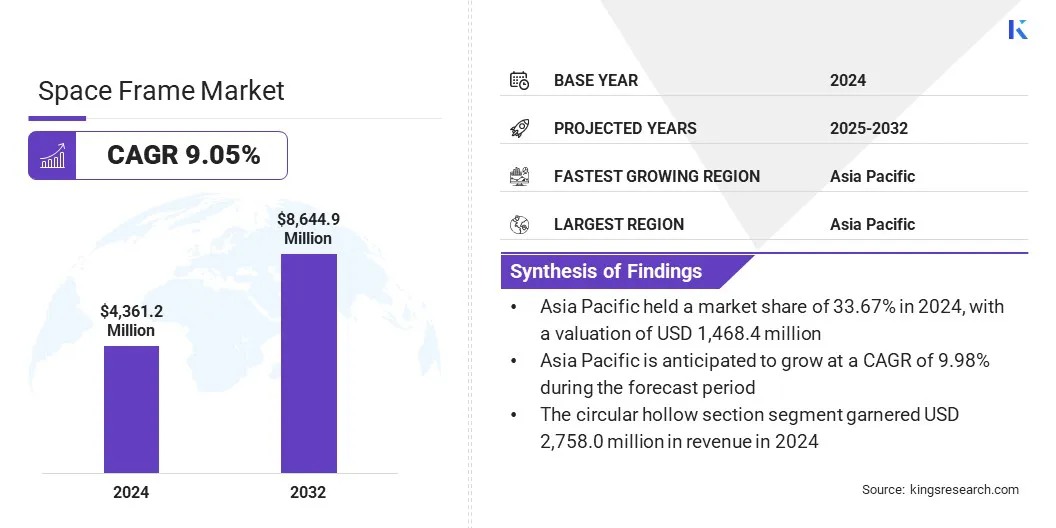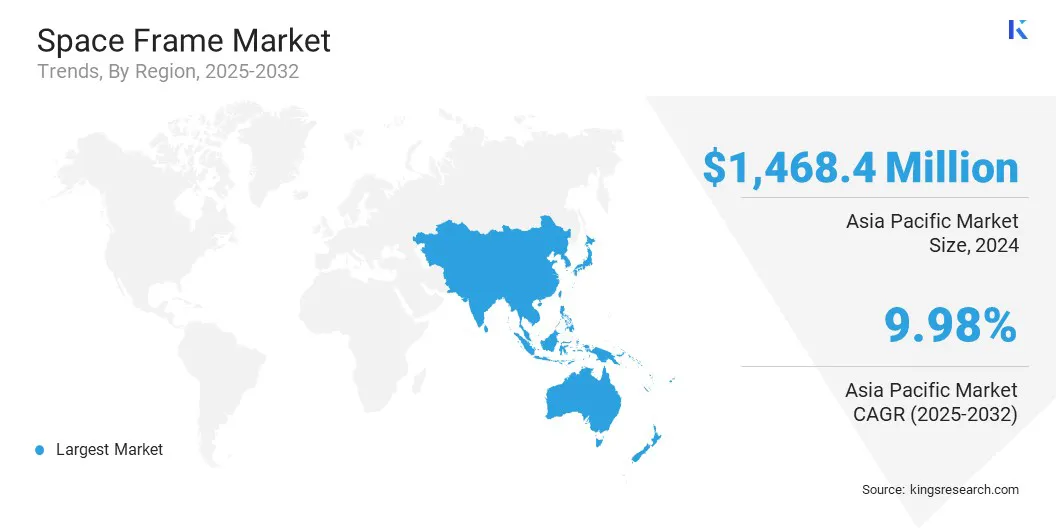Market Definition
A space frame is a three-dimensional structural framework composed of interlinked struts that efficiently distribute loads through a rigid geometric pattern. It provides high strength-to-weight ratio and design versatility, enabling large-span constructions without the need for internal columns.
Applications include roofing systems, atriums, exhibition halls, sports complexes, and transport hubs where both stability and aesthetics are essential. Industries such as construction, infrastructure, aerospace, and industrial facilities adopt space frames for their durability, material efficiency, and architectural flexibility.
Space Frame Market Overview
The global space frame market size was valued at USD 4,361.2 million in 2024 and is projected to grow from USD 4,712.8 million in 2025 to USD 8,644.9 million by 2032, exhibiting a CAGR of 9.05% during the forecast period. This growth is attributed to the rising need for lightweight and durable structural systems that can efficiently support large spans in modern construction projects.
Increasing use of space frames in stadiums, airports, exhibition centers, and industrial facilities is enhancing design flexibility, cost efficiency, and long-term durability, thereby fueling market expansion.
Key Highlights
- The space frame industry size was valued at USD 4,361.2 million in 2024.
- The market is projected to grow at a CAGR of 9.05% from 2025 to 2032.
- Asia Pacific held a market share of 33.67% in 2024, valued at USD 1,468.4 million.
- The steel segment garnered USD 2,288.3 million in revenue in 2024.
- The double layer segment is expected to reach USD 3,499.8 million by 2032.
- The rectangular hollow section segment is anticipated to witness the fastest CAGR of 9.43% over the forecast period.
- The roof structures segment garnered USD 1,508.5 million in revenue in 2024.
- North America is anticipated to grow at a CAGR of 8.68% through the projection period.
Major companies operating in the space frame market are DSI Spaceframes, Hindustan Alcox Ltd, CST Industries, Metalart Space Frame, Triocon Space Frame Technologies Pvt. Ltd., USKON, Lindner SE, Coremetal, Herbert (Suzhou) International Trade Co., Ltd., Gossamer Space Frames, LLC., Pillow Space Frame Ltd, Shandong Huayi Steel Structure & Machinery Co., Ltd, Jiangsu Andy Steel Structure Co., Ltd, Geeta Industries, and Metalkarma Engineering Pvt Ltd.

The growing emphasis of governments, private developers, and the construction industry on infrastructure development and innovative architectural designs is driving the integration of space frames across diverse applications. Additionally, advancements in fabrication technologies, coupled with investments in sustainable and material-efficient building solutions, are accelerating market adoption and growth.
- In August 2023, Elsevier B.V. published a study in Computers & Structures on space frames with complex 3D-printed nodes. The research presents a two-scale modeling approach that improves the accuracy and efficiency of structural analysis for space frames with intricate joint geometries. The proposed method enables better prediction of stress distribution and deformation, supporting optimized design and safer, more reliable construction of large-span space frame structures.
Market Driver
Increasing Infrastructure Development
The growth of space frames is fueled by increasing investment in large-scale infrastructure and modern construction projects. These structures provide lightweight, durable, and flexible solutions for covering wide spans without internal supports, ensuring both stability and aesthetic appeal.
Industries such as commercial construction, transportation, sports facilities, and industrial complexes are increasingly adopting space frames to enhance structural efficiency, reduce material usage, and enable innovative architectural designs. Adoption of space frames is further driven by urbanization initiatives led by governments, infrastructure investments from both public and private sectors, and the focus of developers on sustainable, cost-effective building solutions.
Market Challenge
Complexity in Engineering and Structural Design
Complexity in engineering and structural design creates a significant barrier to the growth of the space frame market. Designing and executing space frame structures requires precise calculations, advanced modeling, and thorough structural analysis to ensure stability, load distribution, and safety. Implementation often demands highly skilled engineers, specialized design software, and meticulous coordination, which can increase project timelines and costs.
Smaller construction firms or developers with limited technical expertise may find it particularly challenging to adopt space frames, creating a disparity with larger, better-resourced organizations.
Industries such as commercial construction, transportation, and sports facilities face additional hurdles, as space frames require exacting standards for safety, durability, and architectural precision. The lack of trained personnel and experience with complex structural frameworks further intensifies adoption difficulties.
To address these constraints, companies are increasingly investing in advanced engineering tools, training programs, and collaboration with specialized design and fabrication partners. These approaches aim to streamline design processes, reduce errors, and accelerate the implementation of space frame structures across projects of all sizes.
Market Trend
Expanding Adoption of Prefabricated & Modular Space Frames
The space frame market is experiencing a shift toward prefabricated and modular construction solutions. This is driven by the need for faster assembly, improved precision, and cost-effective large-span structures. These methods enable off-site fabrication, streamlined on-site installation, and enhanced quality control, ensuring structural stability and architectural flexibility.
This capability is particularly valuable for airports, stadiums, exhibition centers, and industrial facilities, where complex designs and wide spans demand efficient construction approaches.
Organizations and construction firms are increasingly adopting prefabricated and modular space frames to reduce labor requirements, minimize delays, and optimize material usage. Advanced fabrication and modular techniques help improve project timelines, lower costs, and enhance structural reliability. The growing application of these methods is establishing them as key enablers for modern, sustainable, and efficient construction practices.
Space Frame Market Report Snapshot
|
Segmentation
|
Details
|
|
By Material
|
Steel, Aluminum, Metal Alloys, and Others
|
|
By Structure
|
Single layer, Double layer, and Triple layer
|
|
By Tubes
|
Circular hollow section, and Rectangular hollow section
|
|
By Application
|
Roof Structures, Atriums & Skylights, Canopies & Walkways, Bridges & Pedestrian Overpasses, and Others
|
|
By Region
|
North America: U.S., Canada, Mexico
|
|
Europe: France, UK, Spain, Germany, Italy, Russia, Rest of Europe
|
|
Asia-Pacific: China, Japan, India, Australia, ASEAN, South Korea, Rest of Asia-Pacific
|
|
Middle East & Africa: Turkey, U.A.E., Saudi Arabia, South Africa, Rest of Middle East & Africa
|
|
South America: Brazil, Argentina, Rest of South America
|
Market Segmentation
- By Material (Steel, Aluminum, Metal Alloys, and Others): The steel segment earned USD 2,288.3 million in 2024 primarily due to its high strength, durability, and widespread use in large-span space frame structures.
- By Structure (Single layer, Double layer, and Triple layer): The single layer held 41.76% of the market in 2024, due to its simpler design, cost-effectiveness, and ease of installation in various construction projects.
- By Tubes (Circular hollow section, and Rectangular hollow section): The circular hollow section segment is projected to reach USD 5,390.9 million by 2032, owing to its superior strength-to-weight ratio, structural efficiency, and versatility in large-span space frame applications.
- By Application (Roof Structures, Atriums & Skylights, Canopies & Walkways, Bridges & Pedestrian Overpasses, and Others): The bridges & pedestrian overpasses segment is anticipated to grow at a CAGR of 9.50% through the projection period, fueled by increasing urban infrastructure development and demand for durable, lightweight, and cost-efficient structural solutions.
Space Frame Market Regional Analysis
Based on region, the market has been classified into North America, Europe, Asia Pacific, Middle East & Africa, and South America.

Asia Pacific space frame market share stood at 33.67% in 2024, valued at USD 1,468.4 million. This dominance is attributed to rapid urbanization, extensive industrial growth, and significant investment in large-scale infrastructure projects across the region. Rising construction of airports, stadiums, commercial complexes, and transport hubs in this region is driving demand for efficient and durable space frame structures.
Supportive government initiatives, adoption of advanced fabrication technologies, and emphasis on sustainable building practices further strengthen growth prospects. Continuous improvements in modular construction, prefabrication methods, and structural design capabilities position Asia Pacific as a key hub for market expansion.
North America space frame industry is set to grow at a CAGR of 9.98% over the forecast period. This growth is fueled by rising investments in commercial, industrial, and transportation infrastructure, along with increasing demand for large-span and architecturally flexible structures.
Expanding construction projects across airports, stadiums, exhibition centers, and commercial complexes are leveraging prefabricated and modular space frames to improve efficiency, reduce costs, and enhance structural reliability. Additionally, government initiatives promoting urban development, smart city projects, and sustainable building practices are supporting the adoption of space frames, thereby driving market growth in this region.
Furthermore, construction firms are prioritizing faster project execution, precision in design, and optimized material usage, supported by advanced fabrication techniques and skilled engineering expertise, to drive long-term adoption. The growing emphasis on innovative architectural solutions and durable, lightweight structures further propels regional market expansion.
Regulatory Frameworks
- In the U.S., the International Building Code (IBC) regulates building design and construction standards. It ensures structural stability, load-bearing capacity, and safety for large-span frameworks, including space frames, in commercial, industrial, and public infrastructure projects.
- In the European Union, Eurocode 3 (EN 1993) and Eurocode 9 (EN 1999) regulate the design of steel and aluminum structures. They provide guidance on material specifications, structural analysis, and safety factors, ensuring compliance and reliability of space frame constructions across member states.
- In India, the National Building Code of India (NBC) regulates structural design and construction practices. It establishes criteria for steel and modular frameworks, supporting the safety, durability, and efficiency of space frame structures in commercial and industrial applications.
- In Australia, the AS/NZS 1170 Series regulates structural design loads, including wind, seismic, and live loads. It ensures space frame structures meet safety, reliability, and performance requirements under diverse environmental conditions.
Competitive Landscape
Companies operating in the space frame industry are maintaining competitiveness through investments in advanced design software, prefabrication technologies, and strategic partnerships and acquisitions. Market players are expanding their offerings with customized designs, lightweight and sustainable materials, and automated fabrication techniques to meet diverse project requirements and evolving construction standards.
Moreover, they are establishing regional fabrication facilities and collaborating with engineering firms and construction companies to facilitate adoption and enhance project execution. Additionally, companies are providing technical support, design consultation, and training programs to improve implementation efficiency and sustain competitive positioning.
Top Key Companies in Space Frame Market:
- DSI Spaceframes
- Hindustan Alcox Ltd
- CST Industries
- Metalart Space Frame
- Triocon Space Frame Technologies Pvt. Ltd.
- USKON
- Lindner SE
- Coremetal
- Herbert (Suzhou) International Trade Co., Ltd.
- Gossamer Space Frames, LLC.
- Pillow Space Frame Ltd
- Shandong Huayi Steel Structure & Machinery Co., Ltd
- Jiangsu Andy Steel Structure Co., Ltd
- Geeta Industries
- Metalkarma Engineering Pvt Ltd


